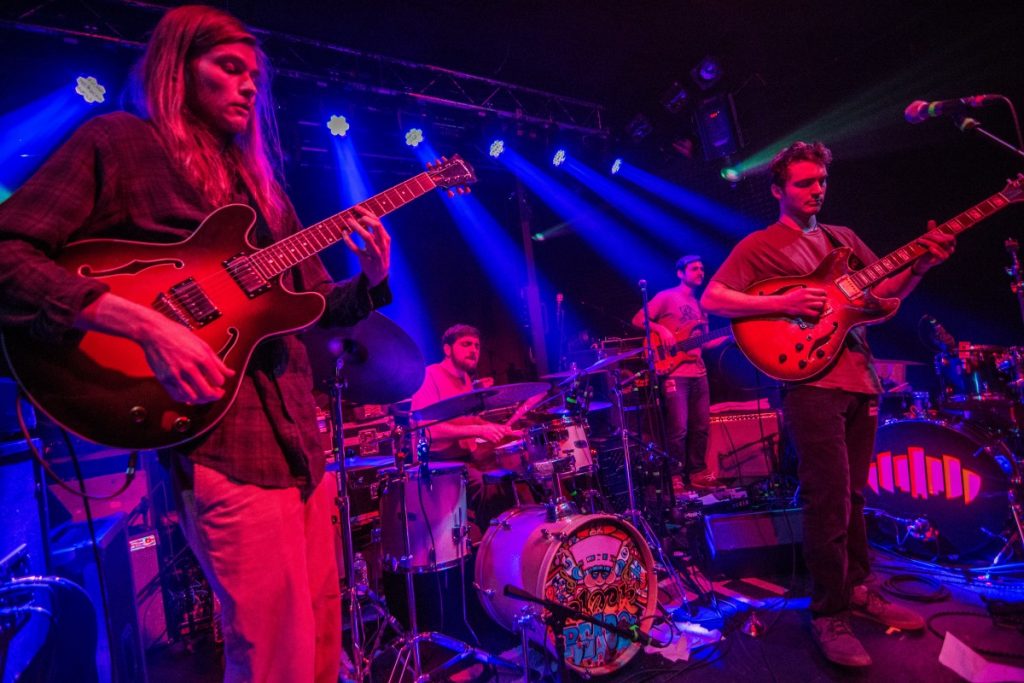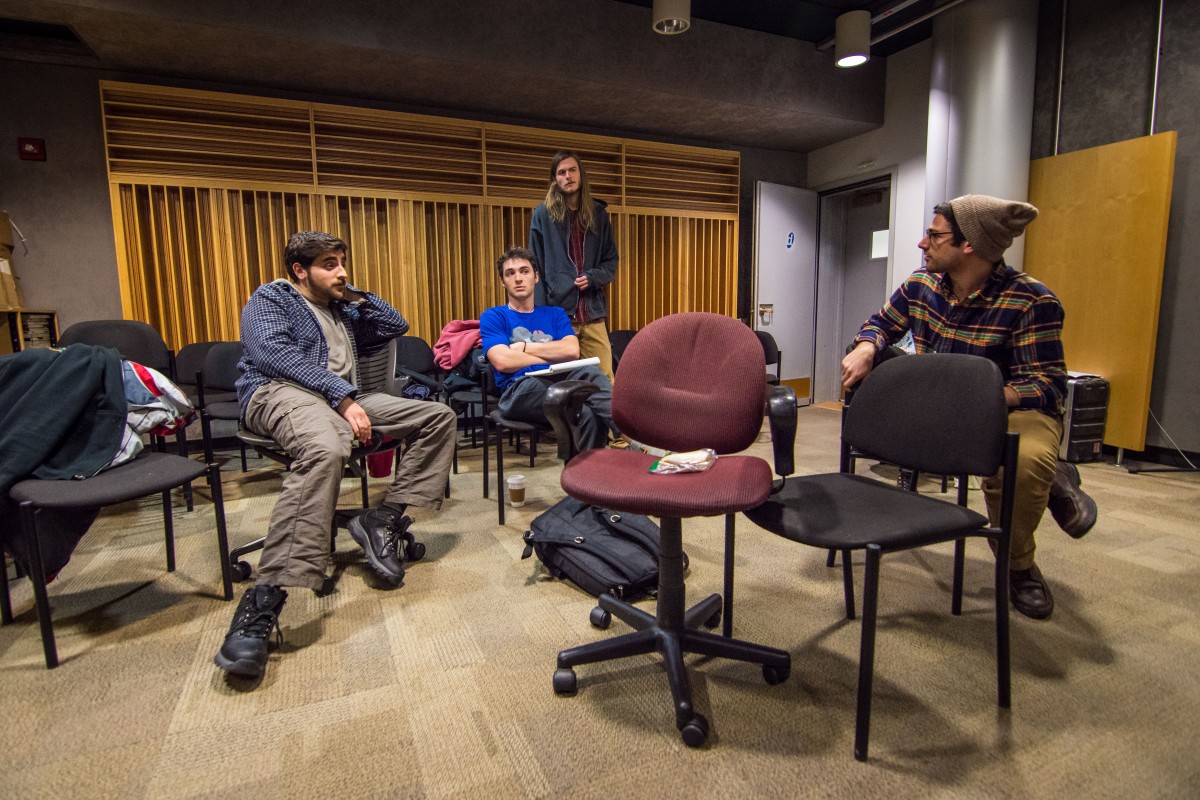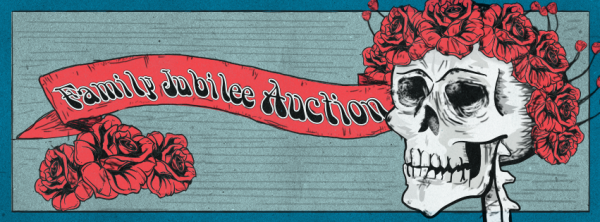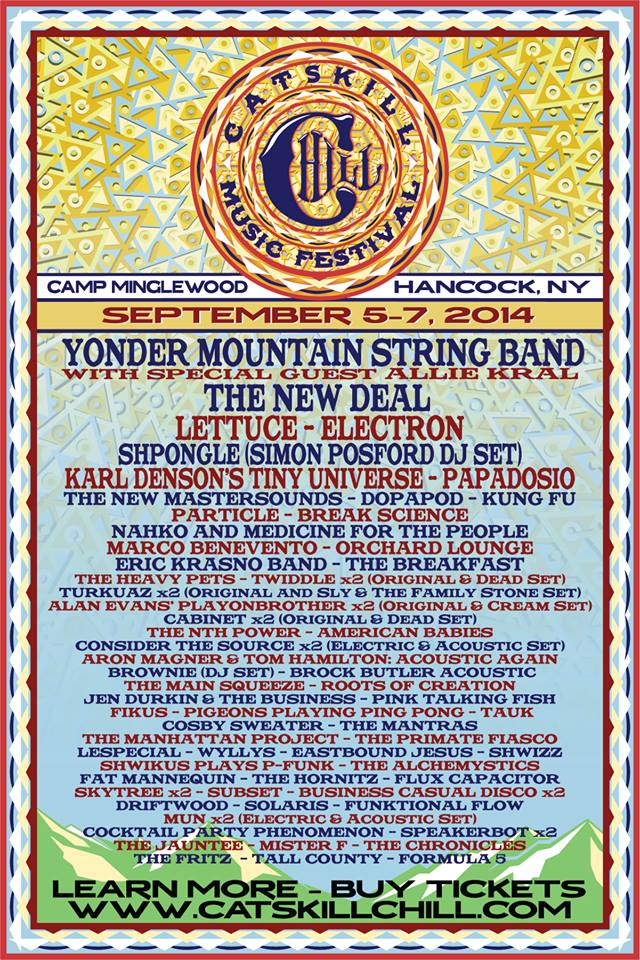By Cooper Green

(Left to right) Steve Ippolito, Jason Greenlaw, John O’Brien and Michael Berger talk about the upcoming album, ‘Inner Peaks,’ at a Carnegie Mellon studio on Dec. 12, 2017. Photo by Pat Bruener
“Is that one of my PBs?” asked bassist Michael Berger, pointing to a ziplock bag protruding from the corner of Jason Greenlaw’s backpack.
Greenlaw laughed and acknowledged that it was one of the peanut butter sandwiches that Berger had made for him the day before. Then he grabbed his guitar and headed into the soundproof recording area of the studio.
The Clock Reads are a jam band, a genre label that means little more than a band whose calling card is improvisational live performance. That approach to music requires constant unspoken communication between the four members of the band, it requires trust, and sometimes it requires that they make each other lunch. And, once properly nourished, these 20-something Pitt grads have ripped, roiled, and weaved through the regional jam band scene since early 2014.
Those keeping tabs may recognize the idea of a “jam band” as a lost art with the decline of ’60s and ’70s jammers like the Grateful Dead and Phish. A young local crop of musicians has kicked things back into gear, however, and The Clock Reads is among the forefront of a retro revival in Pittsburgh.
The band is recording what they would call their first real studio album (a self-titled EP emerged in 2015) at a studio in the Carnegie Mellon College of Fine Arts. “Inner Peaks” is slated for release on April 13, with a 21+ album release party that night at the Rex Theater. Tickets are available via ticketfly.com.
Around 9 p.m. on a Tuesday night in December, the album was still in an early stage of disorganization: the band alternated between detail work — down to mending a drum roll one sixteenth note off — and big-picture changes — nixing entire songs off a clip-boarded track list with the flick of a pen.
There was coffee in the room, despite the hour. The space was a terrific mess of chairs and boxes of old equipment. The members of the band, sans one, were scattered around the studio with their engineer and photographer, filling just enough chairs to give the place the appearance of a high school classroom on Senior Skip Day. Guitarist John O’Brien showed up shortly, hustled over from his gig teaching guitar at Sunburst School of Music.
“You’re dressed up like you just came from Buffalo,” said Greenlaw.
And so the banter began. Three of the four live together, and they’re more like brothers than bandmates. And brothers call each other jags when they blow a take.
“Ohhh, we got a STANKER,” called drummer Steve Ippolito from the recording booth as Greenlaw botched the end of an extended guitar take. The mistake was indiscernible on a casual listen, but the entire band reacted. “Give me the playback on that piece of shit,” called Ippolito.
“Live, that would’ve been funny,” said O’Brien, looking over at me. “But we’re not gonna put that on the record.”
But in the same way that a failure is recognized by the group, the success of one is to the benefit of all. Earlier in the evening, O’Brien attempted to articulate his proposed fix for the hair-off drumroll to Ippolito, using every “bang” and “dun” you might expect a 6-year-old to utilize replicating a favorite song.
When Ippolito somehow understood what O’Brien was going for, and nailed it, O’Brien leapt up and down — his 18-inch brown hair flying every which way — saying, “Yes! That was it! That was it!” with the thrill of a last-second touchdown reception.
Once he settled down, he explained how that sort of expression is really the only way these guys can communicate to each other what they want out of a song. Because even when the desires might seem as simple as “do that thing with the stick,” each member has a specific sound in mind. Unfortunately, because of each’s devotion to their niche, they may as well be speaking different languages.
That’s where table drum rolls and major gesticulation come into play.
“We all kind of know each other’s mannerisms, musical and otherwise,” explained O’Brien. “A lot of our communication is musical. We don’t necessarily talk a lot to each other.”
Berger, the bassist, agreed. It’s a call and response, he said, when the four are trying to finalize a sound.
“I think it does translate, the words we say, the actions we do, that just converts through our instruments.”
Since the band’s birth, they’ve jumped the circuit from basement shows and college dives like Uncle Jimmy’s Bar up to full-scale ballrooms like the Rex Theater, all the while accumulating and dropping sounds and influences like trading cards.
The tracks which they unraveled and mended that night had a grander feel than their previous work. Many featured dueling guitar solos from Greenlaw and O’Brien, who share the lead spotlight rather than relegate to a tiered rhythm/lead structure. Despite a traditional set of instruments, the group conveys a sense of grandeur in space-age riffs.
A combination of influences, from jazz to jam to everything in between, brings this sound to the forefront for the band. If you ask them, it’s what separates their work from the next.
“That’s something we’re good at — we can play all these different styles of music,” said O’Brien. “For me, I’m trying to mesh them more. So I’m trying to not just think ‘I’m playing rock’ or ‘I’m playing jazz.’ I’d rather be like ‘We’re playing The Clock Reads.’”
This is part of what makes the precise sound of The Clock Reads difficult to pin down. It’s always changing. For a group that focuses above all on spontaneity and freedom, a studio album is, more than anything, a framed photo of a moment in the band’s growth.
“We’ve still been working our sound out. And I think this album is a good representation of where we’re at and what’s to come,” said Ippolito.
***

(Left to right) John O’Brien, Steve Ippolito, Michael Berger and Jason Greenlaw perform at the Rex Theater on Dec. 13, 2017. Photo by Pat Bruener.
The following night, “methodical” and “nitpick” were dropped from the band’s vocabulary as they returned to more familiar territory. They played an opening set for Boston-based Dopapod at the Rex Theater in Southside. The Clock Reads run the sort of Jekyll and Hyde operation that most jam bands do: technical perfectionism in the studio and a winding improvisational stage show that lends itself to the regular misstep.
“In the studio I want it to be perfect — or close to perfect,” O’Brien had said the night before. “Live you have to live with it, because it’s gone.”
Lucky for the guys, the jam band regulars don’t mind this approach. They expect it.
But besides the commonality in expectation, the audience has little overlap. A gray-haired ponytail could be spotted whipping around front and center at the stage. To the side, near the tall amps that blast the alternatively droning and technically flexing riffs of the band, stood a handful of stoner-types, decked in hemp sweatshirts with dreaded hair covering the gauges in their ears. In the back, by the sound booth, stood two guys in chest-tight pastel button-ups that appeared to have just walked out of a frat house. Scattered in between these characters was a crowd of people that looked like they could have been anywhere at all.
This was a fairly routine crowd at a Clock Reads show — routine in the consistency of its variety, not the normalcy of its characters. The band draws from nearly every corner of Pittsburgh’s music scene.
“Is this still the same fucking song?” asked one member of the audience.
It’s a light-hearted question, because the person asking paid to be there, but not unwarranted when halfway through a Clock Reads live set. In the studio, distinctions are clear between tracks, and they’re contained. But in the jam band’s natural environment, one song blends into the next, and “one song” can last a long, long time.
And the energetic performance took its toll, based on the spread of the band in the green room upstairs afterwards. They’ve been playing the Rex since 2015, and the living room-esque space the band sprawled across had the feel of a second home to them.
A handful of Stella Artois were pulled from the bench-seat cooler and distributed around.
“That was a rocking show,” Greenlaw said to no one in particular. That seemed to be the consensus — energy was high and every note felt spot-on. “We played our set completely as we wrote it tonight, which doesn’t always happen,” he explained. “A lot of the time we have back-up songs, but this one we actually played start to finish.”
Things went as planned in their improvisation that night, is what he was saying. That isn’t always the case. The guys bounced around memories of old shows for a while, pausing for a moment when I asked for one that really stood out. As with just about everything from The Clock Reads, they all found the answer at once, laughing and nodding when O’Brien was the first to voice it: Creatures of the Night Music and Art Festival in Tennessee in 2015. The first night went off without a hitch. It was day two, when The Clock Reads were set to play, that things went awry.
“We woke up and the main stage had been packed up and the 18-wheeler was pulling out,” said O’Brien, shaking his head at the memory. But the bands who stuck around made something out of nothing, playing full sets on the built-in stage at the venue with an improvised schedule.
“Everyone came together out of this shitty situation and made it what it was,” chimed in Ippolito.
The guys all chipped in bits of recollection then, remembering the 2015 festival-that-wasn’t-then-was in pieces and moments. They were all grinning as they illustrated a day in which a ragtag bunch of musicians came together and figured out how to make music on the fly.
“Out of chaos came something beautiful,” said Ippolito, in what would also be a fitting description of a night with The Clock Reads.

The Clock Reads perform to an eclectic audience at the Rex Theater on Dec. 13, 2017. Photo by Pat Bruener







